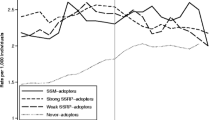Abstract
In the recent Demography article titled “The Effect of Same-Sex Marriage Laws on Different-Sex Marriage: Evidence From the Netherlands,” Trandafir attempted to answer the question, Are rates of opposite sex marriage affected by legal recognition of same-sex marriages? The results of his approach to statistical inference—looking for evidence of a difference in rates of opposite-sex marriage—provide an absence of evidence of such effects. However, the validity of his conclusion of no causal relationship between same-sex marriage laws and rates of opposite-sex marriage is threatened by the fact that Trandafir did not also look for equivalence in rates of opposite-sex marriage in order to provide evidence of an absence of such an effect. Equivalence tests in combination with difference tests are introduced and presented in this article as a more valid inferential approach to the substantive question Trandafir attempted to answer.


Similar content being viewed by others
Notes
The overall Type I error is controlled with α, rather than with α/2, because the intervals defined by H –01 and H –02 do not overlap.
References
Altman, D. G., & Bland, M. J. (1995). Statistics notes: Absence of evidence is not evidence of absence. British Medical Journal, 311, 485.
Anderson, S., & Hauck, W. W. (1983). A new procedure for testing equivalence in comparative bioavailability and other clinical trials. Communications in Statistics—Theory and Methods, 12, 2663–2692.
Badgett, M. V. L. (2004). Will providing marriage rights to same-sex couples undermine heterosexual marriage? Sexuality Research and Social Policy, 1, 1–10.
Dillender, M. (2014). The death of marriage? The effects of new forms of legal recognition on marriage rates in the United States. Demography, 51, 563–585.
Dinno, A., & Whitney, C. (2013). Same sex marriage and the perceived assault on opposite sex marriage. PLoS ONE, 8(6), e65730. doi:10.1371/journal.pone.0065730
Hauck, W. W., & Anderson, S. (1984). A new statistical procedure for testing equivalence in two-group comparative bioavailability trials. Journal of Pharmacokinetics and Pharmacodynamics, 12, 83–91.
Langbein, L., & Yost, M. A. (2009). Same-sex marriage and negative externalities. Social Science Quarterly, 90, 292–308.
Reagle, D. P., & Vinod, H. D. (2003). Inference for negativist theory using numerically computed rejection regions. Computational Statistics & Data Analysis, 42, 491–512.
Schuirmann, D. A. (1987). A comparison of the two one-sided tests procedure and the power approach for assessing the equivalence of average bioavailability. Pharmacometrics, 15, 657–680.
Trandafir, M. (2014). The effect of same-sex marriage laws on different-sex marriage: Evidence from the Netherlands. Demography, 51, 317–340.
Wellek, S. (2010). Testing statistical hypotheses of equivalence and noninferiority (2nd ed.). Boca Raton, FL: Chapman & Hall/CRC.
Author information
Authors and Affiliations
Corresponding author
Rights and permissions
About this article
Cite this article
Dinno, A. Comment on “The Effect of Same-Sex Marriage Laws on Different-Sex Marriage: Evidence From the Netherlands”. Demography 51, 2343–2347 (2014). https://doi.org/10.1007/s13524-014-0338-1
Published:
Issue Date:
DOI: https://doi.org/10.1007/s13524-014-0338-1




